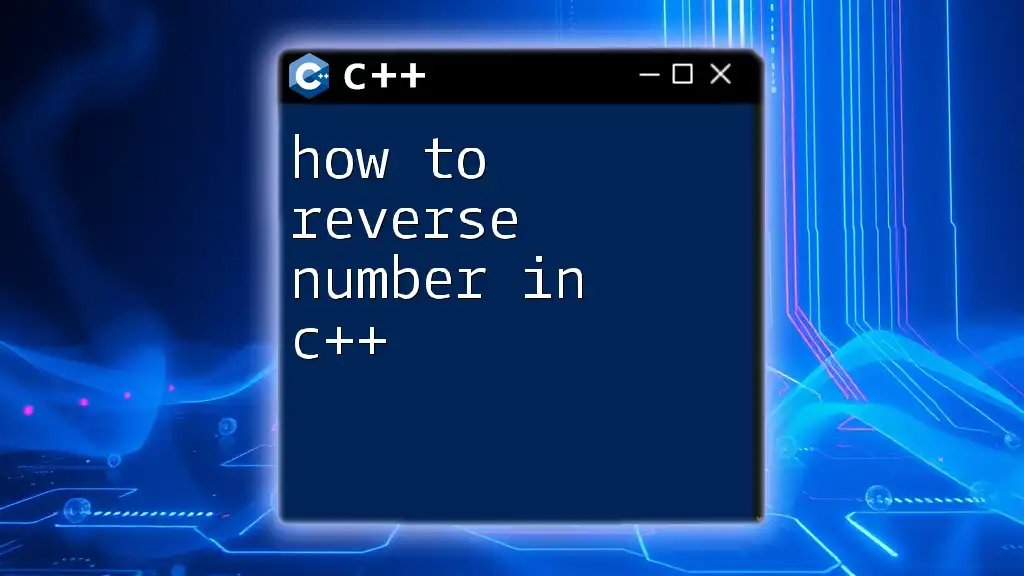To reverse a number in C++, you can use a simple loop to extract each digit and construct the reversed number. Here's a code snippet demonstrating this:
#include <iostream>
using namespace std;
int main() {
int num, reversedNum = 0;
cout << "Enter an integer: ";
cin >> num;
while (num != 0) {
reversedNum = reversedNum * 10 + num % 10;
num /= 10;
}
cout << "Reversed Number: " << reversedNum << endl;
return 0;
}
Understanding the Problem
What Does It Mean to Reverse A Number?
Reversing a number involves flipping its digits to show them in reverse order. For example, the number `12345` reversed becomes `54321`. This concept is not just an academic exercise; it has practical applications in various programming scenarios, such as checking for palindromes, altering data formats, or preparing numbers for specific algorithms.
Basic Approach to Reverse a Number
Step-by-Step Breakdown
To reverse a number, we can follow these logical steps:
- Extracting digits: We can do this using the modulus operator `%` which gives us the last digit of the number.
- Building the reversed number: We multiply the current reversed number by 10 and add the extracted digit.
It's important to consider how to handle special cases like zero and negative numbers. For instance, a negative number would still reverse its digits but should retain its negative sign when presented.
Implementation in C++
Simple Method to Reverse a Number
One straightforward way to reverse a number is by using a while loop. The following code snippet demonstrates this method:
#include <iostream>
using namespace std;
int main() {
int num, reversedNum = 0;
cout << "Enter an integer: ";
cin >> num;
while (num != 0) {
int digit = num % 10;
reversedNum = reversedNum * 10 + digit;
num /= 10;
}
cout << "Reversed Number: " << reversedNum << endl;
return 0;
}
Explanation of the code:
- The line `num % 10` retrieves the last digit of the number, which is then stored in the variable `digit`.
- We construct the reversed number by updating `reversedNum` using the expression `reversedNum * 10 + digit`. This effectively shifts the previous digits left and adds the new digit at the end.
- The while loop continues until `num` becomes zero, indicating that all digits have been processed.
Advanced Methods to Reverse a Number
Recursive Method
In addition to the iterative approach, we can also reverse a number using recursion. Here's how you can implement it:
#include <iostream>
using namespace std;
int reverse(int num, int rev = 0) {
if (num == 0)
return rev;
return reverse(num / 10, rev * 10 + num % 10);
}
int main() {
int number;
cout << "Enter an integer: ";
cin >> number;
cout << "Reversed Number: " << reverse(number) << endl;
return 0;
}
Explanation of recursion in reversing a number:
- The function `reverse` takes two parameters: the number to be reversed and the current reversed number, which by default is zero.
- It checks if `num` is zero, at which point it returns the accumulated reversed number.
- If not, it calls itself recursively, reducing the number by a digit each time (dividing by 10) while building the reversed number through the expression `rev * 10 + num % 10`.
Using String Manipulation
Another method employs string manipulation, which can be more intuitive for some programmers. Here's an example:
#include <iostream>
#include <string>
using namespace std;
int main() {
int num;
cout << "Enter an integer: ";
cin >> num;
string str = to_string(num);
reverse(str.begin(), str.end());
cout << "Reversed Number: " << stoi(str) << endl;
return 0;
}
Advantages and disadvantages of this method:
- The code converts the integer to a string, reverses the string, and converts it back to an integer.
- While this method is easier to read, it may not be as efficient as the numeric approaches, especially with larger numbers.
Error Handling and Edge Cases
Considerations for Input Validation
When creating programs that reverse numbers, it's essential to think about validation. You should account for:
- Invalid inputs: Ensure that the program can handle non-integer inputs gracefully, ideally with error messages prompting the user to enter a valid number.
- Negative numbers: The techniques shown so far will reverse the digits but might not consider the negative sign appropriately. It's advisable to manage the sign separately by storing it and applying it after reversing the digits.
Common Mistakes to Avoid
When reversing numbers in C++, beginners often encounter several pitfalls:
- Integer overflow: If the reversed number exceeds the maximum value an integer can hold, it may lead to unexpected results. Always implement checks to mitigate overflow.
- Incorrect logic: Ensure that the process of extracting and rebuilding the number is correctly implemented, as small mistakes can produce faulty outputs.
- Ignoring edge cases: Failing to check for cases like zero (where the result should still clearly show it as zero) can lead to misleading results.
Conclusion
Learning how to reverse a number in C++ is a valuable skill that encompasses fundamental programming concepts such as loops, recursion, and string manipulation. By understanding the various methods and considerations involved, you can enhance your coding proficiency and tackle more complex challenges with confidence. Experiment with different approaches, refine your skills, and don't hesitate to share your experiences or feedback!
Additional Resources
For those seeking to deepen their understanding further, consider exploring additional articles or online courses that focus on more complex C++ topics, algorithms, and data structures. Engaging with a broader community can also provide invaluable insights and encourages sharing knowledge in this ever-evolving field.








